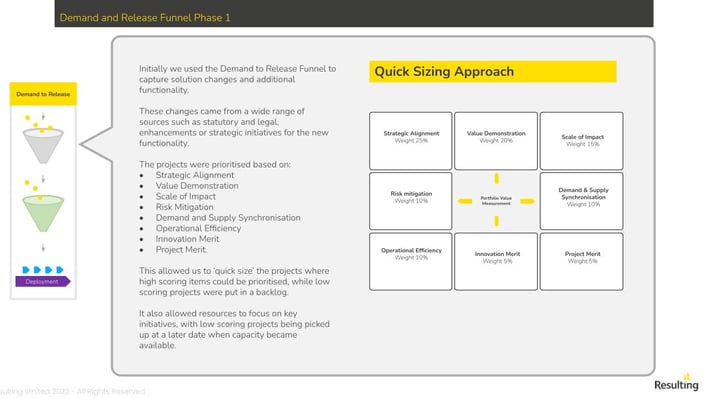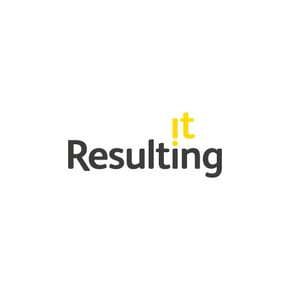Resulting were tasked with helping a major oil and gas company with prioritizing and delivering a complex portfolio of IS projects.
The client was running multiple projects of all shapes and sizes, but with some failing it was proving difficult to form a standardized approach across delivery management and global data sources. Whilst there’s no single version of the truth surrounding project delivery, understanding that requirement information is dispersed around the world trapped within people’s desktops, emails and even on post-it notes, can ease the process.
In the case of this client, they wanted to implement better project portfolio management based on prioritized demand and devise a clear roadmap strategy for project delivery, ultimately delivering the benefits back into the business.
Creating the Project Portfolio & Benefits Realization Roadmap
From early conversations, Resulting surmised that the client has a number of projects running simultaneously - and completely separately - with no company-wide view of the entire portfolio of live projects.
The first step to managing the project portfolio, and creating a practical delivery roadmap, was to sort and prioritize the ongoing projects based on demand and dependencies. With this in mind, Resulting supported the client in utilizing the “Demand to Release Funnel” approach, by categorizing the types of changes, both current and future, we created the delivery roadmap.

Where to start?
The “Demand to Release Funnel” was initially used to capture solution changes and additional functionality. These changes came from a wide range of sources such as statutory and legal, enhancements or strategic initiatives for the new functionality.
These projects were prioritized based on:
- Strategic Alignment
- Value Demonstration
- Scale of Impact
- Risk Mitigation
- Demand & Supply Synchronization
- Operational Efficiency
- Innovation Merit
- Project Merit
This allowed Resulting to ‘quick size' the projects where high-scoring items could be prioritized while low-scoring projects were put in a backlog. It also allowed the client to focus resources on key initiatives, with low-scoring projects being picked up at a later date when capacity became available.
So, what comes after?
Following on from the initial phase, support and maintenance projects were added to the project portfolio. Combined, these phases gave the project management team clarity when it came to the projects required within the business, then allowed them to plan releases and formulate a project delivery roadmap.
It was during this phase that Resulting’s PMO team was onboarded to create a prioritized portfolio based on the classification criteria identified during phase one.
This allowed the client to plan releases in a way that delivered business-critical changes with updates in a timely fashion. It also helped to coordinate projects based on their dependencies and the capacity within the business to deliver them. The portfolio roadmap allowed the client's project management team to communicate a calendar of benefit realizations, increasing business buy-in for projects and increasing satisfaction with senior stakeholders.
It’s time to improve programme governance
The categorization that took place during the “Demand to Release Funnel” process enabled Resulting to apply the relevant governance to each release. This included embedding stage gates, the deliverables that needed to be completed, the appropriate meeting cadence, and the associated risk management.
Large, high-risk projects were managed with greater rigour, while smaller projects were managed in an agile, nimble way to quickly release value into the business. A “Risk-Free Release” was introduced and embedded throughout the IT departments within the organization.
Resulting also reduced the number of roles and responsibilities for each project phase, helping to define the key activities for each role. By introducing improved project portfolio management, as well as project governance, Resulting enabled the client to:
- Prioritize the projects that were most important to the business
- Improve governance around the biggest, higher-risk projects
- Allow smaller, lower-risk projects to be run in a more agile way
- Release value to the business more frequently and efficiently
- Provide a clear roadmap for projects and benefit realization to the business
- Coordinate projects and optimize the workforce
Resulting also implemented new standards around programme governance such as:
- Before projects begin, categorize the initiative and involve the PMO to ensure it is in the right project category
- Use stage gates to enforce Quality Assurance on deliverables through a process of Prepare, Review, Approve
- Between gates, increase programme governance with weekly PMO and project meetings, with weekly reporting to stakeholders
- Define an escalation path for risks and issues
KPIs were also tracked to ensure that the desired behaviours were being adopted.
The solution?
Ensure future initiatives are prioritized against the Portfolio Roadmap. No really, it’s that easy.
Strategic Alignment - (Weight 25%)
- Projects mapped to strategic business thrusts
- Supports critical business function
- Offers competitive advantage
Value Demonstration - (Weight 20%)
- Metrics identified and tracked to measure contribution to business
- Estimated value ROI
- Value relative to budget
Scale of Impact - (Weight 15%)
- Quantitative measure of impact on customers (internal & external)
- Contribution to business performance
Demand & Supply Synchronization - (Weight 10%)
- Response time to business needs
- Aligning resources with market demand
- Meeting budget, scope and schedule goals
Project Merit - (Weight 5%)
- Reusability
- Scalability
- Interoperability
- Portability and Maintainability
Innovative Merit - (Weight 5%)
- Ability to respond to changing market needs
- Next-gen technology
- Stronger market position
Operations Efficiency - (Weight 10%)
- Process centralization and standardization
- Elimination of non-value-add activities
Risk Mitigation - (Weight 10%)
- Prevents risk of disruption to business
- Prevents risk of Legal/Regulatory exposure
- Prevents catastrophic risks
What to consider when enabling functions for Portfolio Management & Project Delivery?
Governance & QA
Basic PMO disciplines to drive standardization, quality and consistencies across projects including:
- On-time and on-budget delivery
- Integrated planning
- Dependency tracking
- Cost models, budgeting, forecasting and tracking
- Governance meetings
- Weekly reporting
- RAID logs
Integrated Planning
Management of the SAP portfolio, based on the GPO roadmaps for SAP including:
- Monthly roadmap reviews
- Governance
- Dependency alignment
- Prioritization of initiatives in line with the agreed roadmaps
Benefit & Value Realization
Ensuring that the benefit and value for each project:
- Underpins business objectives
- Is clearly understood by key stakeholders
- Is in line with the agreed business case
- Is qualified and quantified
- Can be measured
- Can be demonstrated against a committed time frame
Integrated Demand Planning
Qualification and quantification of demand from the integrated portfolio plan to enable:
- Effective release planning
- Predictive resource and capacity planning
- More predictable results from project delivery - right team, right skills and the right level of resources
- Improved cost forecasting










